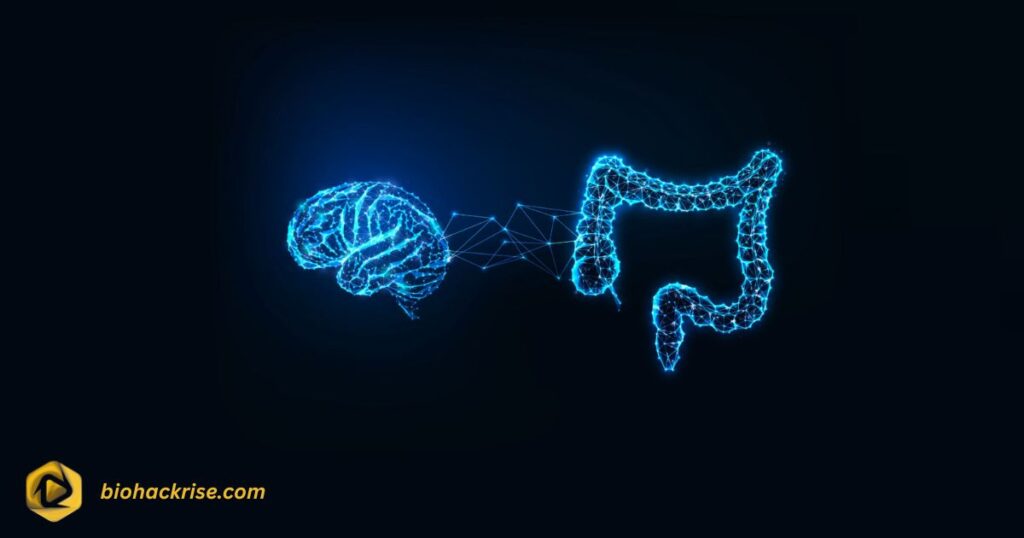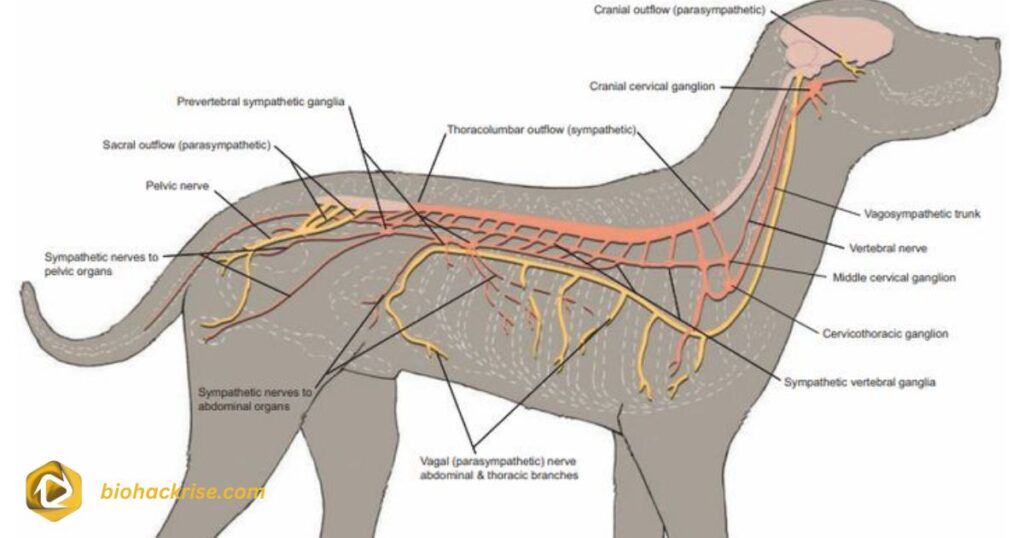Dog Vagus Nerve: Pathway to Your Dog’s Health and Happiness
The vagus nerve in dogs is often overlooked, yet it plays a massive role in maintaining your furry friend’s health and emotional balance. Think of it as your dog’s built-in communication highway one that connects the brain with almost every major organ in the body. When this nerve is functioning optimally, your dog experiences better digestion, a calmer temperament and a stronger immune system.
Just like in humans, the dog’s vagus nerve helps regulate the parasympathetic nervous system the part responsible for “rest and digest.” When the vagus nerve is disrupted or underactive, your dog may suffer from issues like gastrointestinal discomfort, anxiety, irregular heartbeats, or even chronic inflammation.
Understanding how the vagus nerve works, what affects it and how to naturally support it can make a world of difference in your dog’s wellbeing. So, let’s dig deeper into the mysterious and powerful vagus nerve the unsung hero of your dog’s nervous system.
What Is the Vagus Nerve in Dogs?
The vagus nerve, known scientifically as the cranial nerve X, is one of the longest and most complex nerves in the canine body. Originating from the brainstem, it extends all the way down to the abdomen, branching out to influence the heart, lungs, digestive tract and other vital organs.
Its primary job? To transmit information between the brain and the body, ensuring all internal systems stay in harmony. In dogs, the vagus nerve helps regulate:
- Heart rate and breathing patterns
- Gastrointestinal motility (digestion)
- Salivation and swallowing reflexes
- Calming responses and emotional balance
What’s truly fascinating is how this single nerve helps your dog stay calm and content. When activated, it signals the body to relax, lower heart rate, and enhance digestion a process sometimes called vagal tone. High vagal tone equals better stress resilience, while low vagal tone often leads to anxiety, digestive issues and even immune dysfunction.
Anatomy of the Dog’s Vagus Nerve
Anatomically speaking, the vagus nerve runs a remarkable course through your dog’s body. It begins at the medulla oblongata in the brainstem and travels through the neck alongside the carotid artery and jugular vein. From there, it branches into various nerve fibers reaching the heart, lungs, stomach, liver, and intestines.
It splits into two main branches:
- Sensory Branches – These carry information from the organs back to the brain. For instance, if your dog’s stomach is upset, these signals inform the brain to initiate a response.
- Motor Branches – These control muscles in the throat and larynx, regulate heart rate, and manage digestive processes.
Because it’s such a widespread nerve, even minor dysfunction can produce symptoms that seem unrelated from difficulty swallowing to digestive discomfort or breathing irregularities. Understanding this anatomy helps veterinarians pinpoint issues that could otherwise go unnoticed.
How the Vagus Nerve Impacts a Dog’s Health?
The vagus nerve serves as a central control hub for your dog’s overall wellness. It regulates essential body functions without conscious effort — think of it as the body’s “autopilot.” When the nerve is functioning properly, your dog maintains healthy digestion, a steady heart rate, and a calm nervous system. But when it’s overworked or under-stimulated, it can trigger a domino effect of health problems.
For instance, dogs with poor vagal tone may experience chronic digestive issues such as vomiting, diarrhea, or bloating. You might also notice behavioral changes like nervousness, shaking, or excessive barking, especially in stressful situations. Since the vagus nerve communicates constantly between the brain and the gut, an imbalance in one area can quickly affect the other.
Furthermore, the vagus nerve plays a role in controlling inflammation. A well-functioning vagus nerve can help keep inflammation in check, while a damaged or weak one can lead to chronic inflammatory responses, worsening conditions like arthritis or skin allergies. Simply put, when your dog’s vagus nerve is happy, your dog is happy too emotionally, physically, and mentally.
The Gut-Brain Connection in Dogs

You’ve probably heard of the gut-brain connection in humans, but did you know dogs have it too? The vagus nerve is the main communication line between your dog’s gut and brain often called the “gut-brain axis.”
Here’s how it works: your dog’s digestive system is home to billions of bacteria known as the gut microbiome. These microbes produce chemical messengers that communicate with the brain through the vagus nerve. When your dog’s gut bacteria are balanced, it sends “happy” signals to the brain, resulting in improved mood, reduced anxiety, and stronger immunity.
However, poor diet, stress, or illness can throw off this balance, disrupting communication along the vagus nerve. That’s why digestive health and mental health are deeply intertwined in dogs. Supporting the gut with probiotics, prebiotics and a nutrient-rich diet can enhance vagal tone and improve your dog’s overall sense of calm and comfort.
RELATED POST: Are Veneers Bad for Your Teeth Complete Truth You Need to Know
Common Signs of Vagus Nerve Dysfunction in Dogs
Because the vagus nerve affects so many organs, its dysfunction can appear in a variety of ways. Pet owners often mistake these symptoms for unrelated issues, but they may all point to a single underlying cause vagal imbalance.
Common symptoms include:
- Persistent nausea or vomiting
- Difficulty swallowing
- Chronic coughing or gagging
- Bloating or excessive gas
- Rapid or irregular heartbeat
- Poor appetite or sudden weight loss
- Anxiety, restlessness, or aggression
You might also observe that your dog tires easily, has shallow breathing, or struggles to calm down after excitement. These symptoms occur because the vagus nerve is either overstimulated (sending too many signals) or underactive (failing to send enough).
If you notice a combination of digestive and behavioral changes, it’s worth discussing with your veterinarian. A vet familiar with neurological health can perform diagnostic tests to assess vagus nerve function and rule out other conditions.
How Stress and Anxiety Affect the Dog’s Vagus Nerve?
Dogs, like humans, are highly sensitive to stress and chronic stress can wreak havoc on the vagus nerve. When your dog feels anxious or threatened, the sympathetic nervous system (the “fight or flight” system) takes over, causing heart rate and breathing to speed up. Over time, this can suppress vagal tone, preventing the “rest and digest” system from activating properly.
Low vagal tone makes it harder for your dog to relax even in safe environments. This can lead to stress-related issues like poor digestion, irregular heartbeat, or hyperactivity. On the flip side, stimulating the vagus nerve helps activate the parasympathetic system, encouraging calmness, deeper breathing, and better digestion.
Incorporating daily relaxation techniques gentle massage, slow breathing exercises, or quiet bonding time can help your dog’s body return to balance. Reducing stress not only improves vagal function but also boosts emotional stability and strengthens your bond with your pet.
The Role of the Vagus Nerve in Digestion

If your dog often experiences tummy troubles, the vagus nerve might be the missing link. This nerve directly influences stomach acid production, digestive enzyme release, and the movement of food through the intestines.
When functioning optimally, it ensures food moves smoothly from the stomach to the intestines, aiding nutrient absorption and preventing bloating. But when the vagus nerve underperforms, digestion slows down leading to symptoms like gas, constipation, or acid reflux.
Certain conditions such as megaesophagus (an enlarged esophagus) have also been linked to vagus nerve dysfunction, where the nerve fails to properly coordinate swallowing.
Supporting vagal health can dramatically improve digestion. Offering smaller, more frequent meals, ensuring hydration and keeping mealtime stress-free can enhance nerve function naturally. Some holistic vets even recommend light abdominal massages to stimulate the nerve’s activity in the gut.
Heart Rate, Breathing, and the Vagus Nerve
The vagus nerve acts as your dog’s internal “brake system,” regulating both heart rate and breathing patterns. When functioning properly, it sends calming signals that slow the heart rate, deepen breathing, and promote a state of relaxation. This process known as vagal tone regulation keeps your dog’s cardiovascular and respiratory systems in harmony.
During moments of excitement or stress, your dog’s heart rate naturally spikes. Once the stressful event passes, the vagus nerve activates the parasympathetic response, guiding the body back to its resting state. However, when the vagus nerve is weak or underactive, this return to calmness takes much longer, leaving the dog anxious or hyperactive.
Studies have shown that dogs with strong vagal tone experience better heart rate variability (HRV) a key indicator of resilience to stress. Higher HRV means the vagus nerve can quickly adapt to changes, whether during playtime or rest.
Practical ways to support this function include calm breathing exercises, gentle massage, and daily walks in a peaceful environment. These activities naturally stimulate the vagus nerve, enhancing circulation, respiratory rhythm, and emotional balance.
How to Stimulate the Dog’s Vagus Nerve Naturally?
Stimulating the vagus nerve doesn’t always require complex treatments. In fact, simple, everyday activities can help boost vagal tone and improve your dog’s overall well-being. Here are several natural and effective ways to do it:
- Massage and Touch Therapy – Gentle strokes along the neck and chest can activate vagal pathways. Regular massage reduces stress hormones and encourages relaxation.
- Slow, Rhythmic Breathing – Guide your dog through slow breathing exercises by gently calming them with your voice or touch. This encourages deeper, more rhythmic breaths that activate the parasympathetic system.
- Singing or Humming to Your Dog – The vibration of your voice can indirectly stimulate the vagus nerve through resonance in the chest and throat area.
- Cold Exposure – Short, safe bursts of cool air or water (such as a splash of cool water on the chest) can trigger vagal activity and improve circulation.
- Positive Social Interaction – Gentle playtime, cuddling, and eye contact all enhance oxytocin levels, which are linked to higher vagal tone.
These methods are safe, natural, and easy to incorporate into your dog’s daily routine. Over time, they help regulate your dog’s body systems and create a sense of inner balance and calm.
Massage Techniques for Vagus Nerve Activation
One of the most effective methods to support vagal stimulation in dogs is through targeted massage. The key areas to focus on are the neck, throat, chest, and belly regions rich in nerve pathways and pressure points.
Here’s a step-by-step guide:
- Start at the Neck: Use your fingertips to gently massage the area just below the jawline, moving downward in slow circular motions. This region houses major branches of the vagus nerve.
- Move to the Chest: Place your hand over the center of the chest and apply light pressure with circular movements. This helps calm the heart and encourage steady breathing.
- Massage the Belly: With your palm, gently rub your dog’s stomach in clockwise circles to stimulate digestion and enhance gut-brain communication.
- End with Gentle Ear Rubs: The ear canal has a direct connection to the vagus nerve. Lightly rubbing the base of the ears can have a surprisingly calming effect.
Performing this 10–15-minute massage daily can reduce anxiety, aid digestion, and even improve sleep quality. Always ensure your dog is comfortable and relaxed during the session. If your dog shows signs of pain, stop immediately and consult your veterinarian.
Breathing and Calming Exercises for Dogs
While it might sound unusual, dogs can benefit greatly from calm, rhythmic breathing sessions guided, of course, by you. Controlled breathing helps lower heart rate, reduce anxiety, and stimulate the vagus nerve naturally.
Try this simple method:
- Sit beside your dog in a quiet environment.
- Begin breathing slowly and deeply, exaggerating your inhales and exhales so your dog can sense your rhythm.
- Place a gentle hand on your dog’s chest or back to establish connection.
- Continue this for 3–5 minutes, maintaining a soothing tone and calm energy.
You’ll notice your dog’s breathing begins to match yours, heart rate slows, and muscles relax. This shared calm state not only strengthens the vagus nerve response but also deepens the emotional bond between you and your pet.
For dogs prone to anxiety, combining these sessions with calming music or aromatherapy (such as lavender or chamomile) can further enhance the benefits. Over time, this routine becomes a powerful tool for emotional regulation and nerve health.
Nutrition and the Vagus Nerve: What to Feed Your Dog?

Diet plays a crucial role in maintaining the health of your dog’s vagus nerve and the entire nervous system. The connection between the gut and the brain means that what your dog eats can directly affect nerve function and mood.
Key nutrients that support vagal health include:
- Omega-3 Fatty Acids: Found in fish oil and flaxseed, these fatty acids help reduce inflammation and promote nerve integrity.
- B Vitamins (especially B12 and B6): Essential for nerve repair and neurotransmitter production.
- Probiotics and Prebiotics: They nourish the gut microbiome, improving communication along the gut-brain axis.
- Magnesium: Known as the “relaxation mineral,” it supports nerve transmission and muscle relaxation.
- Antioxidants: Foods like blueberries and spinach help protect nerve cells from oxidative damage.
Avoid processed foods, artificial additives, and excessive carbohydrates, as these can lead to gut imbalance and weaken vagal tone. Opt for natural, whole-food-based diets raw or lightly cooked that provide both nutrition and digestive comfort.
Supplementing with canine-safe probiotics or omega-3 oils can further boost nerve resilience. When your dog’s gut and brain are in sync, their mood, digestion, and energy levels improve dramatically.
Veterinary Treatments and Vagus Nerve Therapy
While natural approaches are incredibly beneficial, some dogs may require medical intervention to manage vagus nerve dysfunction. Veterinarians can offer several evidence-based treatments to restore proper vagal function, depending on the root cause of the problem.
One modern method gaining traction is Vagus Nerve Stimulation (VNS) therapy. This involves using a mild electrical impulse to stimulate the nerve, encouraging balance between the parasympathetic and sympathetic systems. Though this treatment is more common in humans, some advanced veterinary centers have begun exploring it for dogs with chronic epilepsy, anxiety, or digestive disorders.
Other veterinary treatments may include:
- Acupuncture: Stimulates specific meridian points along the body that correspond to vagal pathways.
- Chiropractic adjustments: Helps align the cervical spine, improving nerve flow and communication.
- Medication: In some cases, anti-inflammatory or neurological support medications are prescribed to reduce nerve irritation.
- Laser therapy: Low-level laser treatments can promote cellular regeneration and reduce nerve inflammation.
Veterinarians might also recommend diagnostic imaging (such as MRI or CT scans) to detect any structural issues impacting the nerve. Early diagnosis is essential the sooner a problem is identified, the easier it is to prevent long-term complications.
Regardless of the treatment method, the goal remains the same: to restore vagal tone and reestablish smooth communication between your dog’s brain and organs.
Vagus Nerve and Canine Behavior
Did you know that your dog’s vagus nerve affects their personality and emotional responses? The connection between the nervous system and behavior is stronger than most pet owners realize.
A well-functioning vagus nerve helps dogs remain calm, sociable, and emotionally stable. When it’s working as it should, your dog can transition easily between excitement and relaxation. However, when vagal tone is low, dogs tend to overreact to minor triggers barking excessively, trembling, or showing aggression during stress.
Scientific research supports this link: dogs with higher heart rate variability (a marker of good vagal function) display better emotional regulation and adaptability. Essentially, a strong vagus nerve helps your dog stay cool under pressure.
Practical ways to enhance this connection include:
- Consistent training routines – predictability builds security and reduces stress.
- Positive reinforcement – rewards release dopamine and oxytocin, both beneficial for vagal health.
- Mindful play – gentle, interactive play helps regulate energy and calm hyperactive dogs.
By understanding the vagus nerve’s role in emotional balance, you can better interpret your dog’s behavior and create an environment that supports both mental and physical peace.
How to Support Vagus Nerve Recovery After Injury or Trauma?
In some cases, the vagus nerve can become damaged due to injury, infection, or surgical complications. Recovery takes time, but with the right care, your dog’s nervous system can heal and regain balance.
Here are several ways to support recovery:
- Gentle Rehabilitation Exercises: Encourage light movement and stretching under veterinary supervision. Physical therapy can help reestablish nerve signals.
- Anti-Inflammatory Diet: Incorporate foods rich in omega-3s, turmeric, and antioxidants to reduce inflammation and support healing.
- Massage and Touch Therapy: Continue gentle massages around the neck and chest to stimulate nerve pathways.
- Consistent Routine: Dogs recovering from nerve trauma need structure. Regular feeding, sleeping, and exercise schedules help restore normal autonomic rhythms.
- Veterinary Follow-ups: Periodic assessments ensure healing progress and help detect any recurring issues early.
Healing the vagus nerve is not an overnight process it may take weeks or even months. But with patience, care, and the right interventions, your dog can regain nerve function and return to a happy, healthy state.
Holistic and Natural Supplements for Nerve Health
Supporting your dog’s nervous system with natural supplements can make a big difference in vagus nerve health. The key is to use evidence-backed, veterinarian-approved ingredients that promote nerve repair, reduce inflammation, and balance neurotransmitters.
Top supplements for vagus nerve and nervous system health include:
- Fish Oil (Omega-3 DHA/EPA): Strengthens nerve membranes and supports brain communication.
- Vitamin B Complex: B1, B6, and B12 are vital for nerve regeneration and function.
- Magnesium Glycinate: Promotes relaxation, reduces muscle tension, and supports nerve conductivity.
- L-Theanine: A natural amino acid from green tea that reduces anxiety and improves vagal tone.
- Probiotics: Strengthen the gut-brain axis, enhancing communication through the vagus nerve.
Always consult your veterinarian before starting supplements to ensure proper dosing and safety. Natural therapies often work best when combined with lifestyle and environmental support. Over time, these small changes can significantly boost your dog’s vagal activity and resilience to stress.
Preventing Vagus Nerve Disorders in Dogs
Prevention is always better than cure and when it comes to the vagus nerve, consistent care and awareness go a long way. By making a few mindful adjustments to your dog’s lifestyle, you can protect their nerve health for years to come.
Prevention strategies include:
- Balanced Diet: Provide nutrient-dense, whole foods to nourish both brain and gut.
- Regular Exercise: Physical activity stimulates nerve communication and improves heart rate variability.
- Stress Management: Minimize exposure to loud noises, chaotic environments, or aggressive training.
- Routine Vet Visits: Early detection of nerve-related issues prevents long-term complications.
- Adequate Rest: Sleep is critical for neurological repair and vagal recovery.
Just like humans, dogs thrive in environments where they feel safe, loved, and connected. A stable emotional environment naturally supports stronger vagal tone, leading to better digestion, mood, and immune function.
FAQ’s
What are the first signs of vagus nerve problems in dogs?
Common signs include difficulty swallowing, digestive upset, changes in breathing, or anxiety. Early recognition is key to treatment.
Can I stimulate my dog’s vagus nerve at home?
Yes. Gentle massage, calm breathing sessions, and positive interaction are simple ways to boost vagal tone naturally.
Is vagus nerve stimulation therapy safe for dogs?
It’s generally safe under veterinary supervision, especially for chronic issues like seizures or anxiety.
Does diet affect the vagus nerve?
Absolutely. A nutrient-rich, anti-inflammatory diet supports gut health, which directly influences the vagus nerve.
Can stress permanently damage the vagus nerve?
Chronic stress can weaken vagal tone but rarely causes permanent damage if addressed early through relaxation, diet, and care.
Conclusion
The vagus nerve might be invisible to the naked eye, but its influence runs deep through every aspect of your dog’s life. From digestion and breathing to emotional balance and heart health, this powerful nerve acts as the bridge between body and mind.
By understanding and nurturing your dog’s vagus nerve, you’re doing more than preventing illness you’re giving your furry friend the foundation for a calm, balanced, and vibrant life. Through gentle care, proper nutrition, stress reduction and regular veterinary check-ups, you can keep this vital nerve functioning at its best.




